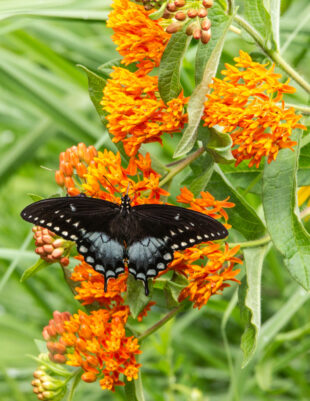
The spring and summer months are when gardens are the most colorful, but it is easy to make our fall and winter gardens interesting as well. Shrubs are especially helpful as they are easy to care for once established, and come in a variety of colors, textures, and sizes. For example, evergreen shrubs offer year-round appeal and are available in many sizes and forms. Some dwarf varieties fit even the smallest gardens. These evergreens have been developed to provide an assortment of colored foliage, including chartreuse and blue-gray, to light up the winter landscape.
Shrubs that have at least two-season interest are good candidates for home gardens. For example, Itea (eye TEE ah) ‘Henry’s Garnet’ is a small native cultivar with white blooms in summer and dark red foliage in fall. Look for other shrubs that give more than one season of interest, such as drought-tolerant native sumac Rhus aromatica ‘Gro-Low.’ Also consider Viburnum, which attract birds and pollinators. Sadly, not all varieties are deer resistant.
Our native spicebush, Lindera (lin DER ah), has flowers, fragrance, and gold foliage in the fall, and the female bushes produce bright red fruit (drupes) in autumn that are enjoyed by the birds. They are host plants for the spicebush swallowtail butterfly and are deer resistant.

Both the red and black chokeberry, known as Aronia (uh RON ee uh), grow 8 feet high and wide, produce fruit, brilliant fall color, and are host for the coral hairstreak butterfly. Native ninebark, Physocarpus (fy so CAR pus)—the name refers to the peeling, multi-colored bark—produces clusters of small spring flowers where pollinators can easily land. This native has cultivars of different sizes and foliage colors and attracts the caterpillars of the spring azure butterfly.
Clethra (kleth ruh) has summer blooms and yellow foliage in autumn, but dislikes too much sun in the heat of the day. Cinnamon-colored bark and a fragrance that attracts pollinators and hummingbirds makes it a favorite in my garden. Another summer bloomer that I would not be without is the chaste bush Vitex ( Vye tex), which produces lovely blue-purple flowers for bouquets, and pretty but astringent-smelling foliage that deer distain. Medieval monks used the seeds of this shrub to quell their sexual urges, hence the common name. In our climate it grows as a tall shrub that is killed to the ground each winter but comes back the following year. It adds a lacy texture to garden borders through the summer and fall.
Observe what you admire in other gardens as you drive around town during the fall and winter months, then take a photo to show to your landscaper, asking about shrubs to enhance your garden in every season. Fall is a good time to plant in our zone, so make the most of the opportunity to plant more shrubs with fall and winter interest now. The sooner you plant them, the longer you will enjoy a varied landscape throughout the year.







